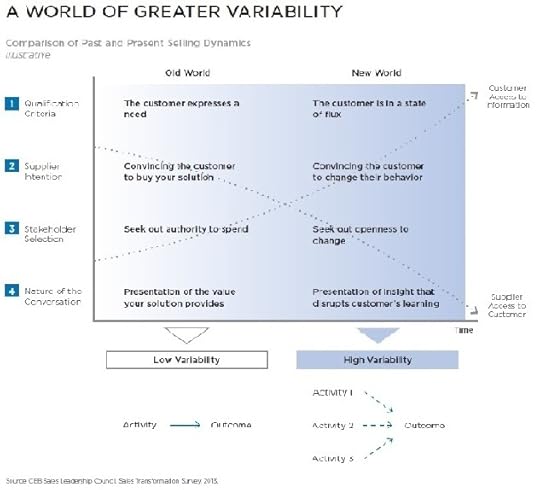Brent Adamson's Blog, page 12
June 24, 2013
How to Get Reps to Exercise Judgment
 In my last post I talked about the increasing nature of variability within sales today. Most of us will agree that even in largely transactional businesses there is an increasing need for reps to be able to apply judgment to their interactions with customers. It may be about finding the right stakeholders, or identifying prospects open to teaching, the need to innovate and adapt is paramount.
In my last post I talked about the increasing nature of variability within sales today. Most of us will agree that even in largely transactional businesses there is an increasing need for reps to be able to apply judgment to their interactions with customers. It may be about finding the right stakeholders, or identifying prospects open to teaching, the need to innovate and adapt is paramount.
Many of our members though struggle with the best way to ensure reps have the discretion they need to flex to a situation, while making sure that the needs of the business are served. Our opinion is that using a careful application of guided judgment can support both aims.
Guided judgment is about identifying the important outcomes to look for at each stage of the buying cycle and allowing managers and reps to innovate on the best means to use to achieve that outcome (within reason of course). One member, ADP, has found a unique process that places helpful guardrails (and ensures transparency) while still allowing reps to adjust their approach to each customer.
ADP uses customer verifiers to ensure reps are progressing through each sale and that their customers are progressing with them, ensuring a lower volume of ‘no deal’ outcomes. Managers work with reps, understanding if particular stage-gates have been met, indicating a customer is ready to move forward in their buying process. If a rep can’t identify a concrete buyer signal that deal is not yet ready to progress and the rep is encouraged to re-engage with the customer at that point in the sale until they see specific action. This emphasis on interim outcomes reduces subjective estimates, clarifies planning and encourages creativity.
CEB Sales members: Learn more about the impact of an empowerment climate on reps’ ability to innovate by listening to our webinar replay: Managing in the Insight Selling Era, and help your managers promote a climate that supports rep judgment using our FLIP tool.
June 17, 2013
Overcoming Sales’ Unpredictability
As many of you know from our work over the past several years at the CEB Sales Leadership Council and confirmed by your experiences with buyers, the empowered customer has fundamentally changed the nature of selling. It’s a situation we didn’t choose, but rather one that has happened to us.
The “old world” of selling was defined by being a highly efficient, “Six Sigma” sales organization, meant to outperform our competitors to meet customer needs. This is how we won. But today, the “new world” of selling requires reps to reframe customer thinking, to “unteach” what they have already learned. The results of this dramatic shift to our sales approach? A world of high variability—driven by an increase in information access for customers and our reduced access to them.
It’s also a world where there is no longer a single path to a single outcome, but multiple, possible paths to a variety of outcomes. What do we mean? Let’s look at four key attributes of sales strategy:

Qualification Criteria: What did we do in the old world? We built scorecards. We identified the appropriate criteria we’d need to find that “motivated buyer” to put into the funnel and move through the funnel. The most common? BANT – Budget, Authority, Need, Timeline. But today, that just gets to the commoditization of products and solutions. It puts you at the RFP place, where we are one of the three suppliers bidding for the deal. So, what do today’s best sellers look for in this new world? Customers in a state of flux. That’s right, they’re looking for change. Customers dealing with and facing internal or external disruption or change.
Supplier Intention: What’s our goal as a supplier? In the old world, it’s to convince our customers to purchase our solution. Pretty straight-forward. In the new world, it’s convincing the customer to change their behavior. As one senior executive told us, “my best sellers don’t sell my company’s solutions, they sell change.” That’s a very different goal.
Stakeholder Selection: What did we look for in the old world? Follow the money, as I used to be told. We look for who had authority to spend and we would look for coaches or advocates in the customer account. But where does that get us today? Either in procurement or a lack of engagement with the right people. In this new, empowered customer world, where do the best sellers go? As many of you know from our past work, they seek out those open to change. It stands to reason, that if I’m selling change, I need to find people who are open to change—people we have come to call Mobilizers. And the kicker? You can’t find Mobilizers on the org chart. They aren’t the Chief of this or the VP of that. They are Bob, Susan, Jim and Mary.
Nature of the Conversation: In the past, to win, we focused our sales conversation on the value of our solution. We nailed that all important value prop and made sure every seller knew it and could articulate it. In the new world, customers can look us in the eye and say, “yep, we know. We already learned that”. What is the conversation to have in the new world? Insights . Teaching or unteaching the customer that disrupts their learning. A conversation that will then lead to your unique differentiators in the markets that you compete.
All of these dynamics lead to greater variability. Think about all the POSSIBLE activities and outcomes our sellers will have to manage and figure out as they go through those four areas. As many of you have told us (and we’ve seen in the research), sales is as complex as ever before. And it’s because of this increased variability—where there are many paths to the right outcomes, but potentially as many paths to the wrong one. This year is the first time we’ve truly come to appreciate that fact, in our work on understanding the type of climate sales leaders and front-line managers need to create to help sellers succeed in this highly variably environment—one we’re calling “guided rep judgment”.
CEB Sales Members, review the key findings from the study, Empowering Reps to Sell to Empowered Customers, to learn more about what this climate looks like and how to make it happen. Also, register for one of our upcoming Executive Retreat or Regional Briefing sessions.
June 16, 2013
iPads: Changing the Sales Game
 Sales operations and enablement teams are constantly looking for new and compelling ways to equip their sales force to better service customers. Many sales organizations are experimenting with mobile solutions—like smartphones and tablets—useful in reaching reps on-the-go. Reps use their tablets for a number of tasks such as presenting sales collateral, reviewing account and pipeline information, communicating with customers and internal stakeholders, and preparing for sales calls.
Sales operations and enablement teams are constantly looking for new and compelling ways to equip their sales force to better service customers. Many sales organizations are experimenting with mobile solutions—like smartphones and tablets—useful in reaching reps on-the-go. Reps use their tablets for a number of tasks such as presenting sales collateral, reviewing account and pipeline information, communicating with customers and internal stakeholders, and preparing for sales calls.
The iPad in particular has garnered much attention in the tablet technology space. The tablet’s popularity is reflected in the fact that 75% of surveyed organizations using tablet technology use the iPad.
In our recent brief, “Deploying iPads to the Sales Force,” we profiled four members with an iPad-enabled sales force to hear their story of deployment, challenges, and successes. As companies approach the deployment decision, and subsequent planning process, there are a number of factors to keep in mind. We asked our profiled members the following questions about their iPad deployment experience:
How and when did you deploy iPads to the sales force?
What type of iPad training and IT support do you provide to salespeople?
What apps and accessories do you recommend or require for sales force iPad use?
What is the primary use of the iPad?
Do you have any advice to offer on iPad deployment based on your experience?
Some of the most important elements of the profiled members’ programs were: initiating a pilot program to uncover potential stumbling blocks, developing training (formal or informal) for iPad users, and enabling reps access to the organization’s internal programs, services, and tools. Profiled members also identified ensuring security, while simultaneously allowing access to CRM, email, document storage, and secure network services as a key challenge in the successful deployment of tablet devices.
CEB Sales Members, review the full report, Deploying iPads to the Sales Force, and use the company profiles to validate or compare your organizations’ iPad deployment plans.
Featured Resources:
Using iPads and Tablets as Sales Tools
iPads and Other Tablets as Selling Tools: Member Perspectives
June 11, 2013
Why Reps Struggle to Close the Sale
 In our last blog post, we discussed how delivering tailored insights to customers has become table stakes in an era of sales where customers are better informed and more empowered than ever before. But as CEB Sales discovered in our 2011 research, Rewriting the Playbook, even the best insights will fall flat if reps aren’t engaging the right types of customer stakeholders, known as Mobilizers.
In our last blog post, we discussed how delivering tailored insights to customers has become table stakes in an era of sales where customers are better informed and more empowered than ever before. But as CEB Sales discovered in our 2011 research, Rewriting the Playbook, even the best insights will fall flat if reps aren’t engaging the right types of customer stakeholders, known as Mobilizers.
In this study, we found that not only do the best reps orient towards Mobilizers, but they also engage them in a fundamentally different way than their core performing peers engage other customer stakeholders. Because Mobilizers tend to be focused on driving change and not a particular supplier’s solution (i.e. your solution), the best reps actively guide Mobilizers through the buying process in a way that not only equips the Mobilizer to drive consensus around your insights and solution in the customer organization, but also leads to you as the supplier. We call this approach Commercial Coaching.
Commercially Coaching Mobilizers to build consensus in their organization involves a series of interdependent steps which draw upon rep’s past experience selling to other customers as well as their ability to innovate in-the-moment based on the context of the situation at hand. That said, a rep’s ability to successfully innovate and exercise judgment in the sale relies heavily on questioning skills.
But, CEB Sales has found that most companies struggle to get reps to ask better questions as training on discovery and questioning skills seems to always fall short—and that’s because the key to getting reps to ask better questions isn’t through skills training, but instead by building an investigative mindset.
Start by helping your reps understand that it’s not always about closing. Rather, show them that they are actually better served by taking the time to do some investigating to uncover potential obstacles to implementing your solution in the customer organization. Reps that have taken the time to arm themselves with such information, for instance, would be able to Commercially Coach their Mobilizer to preempt potential roadblocks and close deals that likely would have stalled out otherwise.
CEB Sales Members: learn how your managers can better prepare your sellers to sell in today’s Insight Selling Era by building an investigative mindset with the Investigative Questioning Toolkit. Also make sure to check out our latest research, Driving Sales Transformation, to learn more about the sales culture that your organization needs to have in order to drive winning sales behaviors.
June 9, 2013
6 Characteristics of a Winning Sales Culture
 In recent posts we discussed why the current sales culture, or climate, of sales organizations is inhibiting Challenger Selling rather than promoting the adoption of winning sales behaviors. In a world in which customers no longer need to engage suppliers for information, sales organizations must take a close look at their existing sales climate and ask themselves whether their organization is helping or hindering reps’ ability to deliver Insights.
In recent posts we discussed why the current sales culture, or climate, of sales organizations is inhibiting Challenger Selling rather than promoting the adoption of winning sales behaviors. In a world in which customers no longer need to engage suppliers for information, sales organizations must take a close look at their existing sales climate and ask themselves whether their organization is helping or hindering reps’ ability to deliver Insights.
So what does the right sales climate for Insight Selling look like?
As we revealed in our most recent research study: Driving Sales Transformation, the sales climate that best support reps’ ability to sell to empowered customers is one that permits judgment. In fact, sales organizations with judgment-oriented climates see a 23% increase in rep adoption of Insight Selling behaviors.
The defining attributes of a judgment-oriented sales climate include:
Intrinsic Motivation – a climate where reps are motivated by peer acceptance and social signals in support of Insight Selling.
Discretion on Building a Pipeline of Business – organizations that encourage reps to create demand early in the funnel, rather than react to it, by promoting pipeline building over pipeline velocity and throughput.
Empowerment – climates that empower reps to take ownership and accountability for their business, and in which reps are managed to outcomes rather than activities.
Emphasis on Principles over Rules – sales climates in which managers allow and encourage principled exceptions to rules and process, and coach reps to develop judgment.
Reward Business Building over Selling – organizations that incentivize reps based on the overall profitable growth of their book of business, rather than on metrics that monitor compliance to a particular sales process.
Sales Innovation – climates that encourage innovation by giving reps increased latitude to determine how they achieve sales targets though sales innovation and adaptability.
Want to learn more about what progressive organizations are doing to influence their climate and allow reps to exercise more judgment? Stay tuned for our next blog post in this series.
CEB Sales Members, register for one of our upcoming Executive Retreat or Regional Briefing sessions to learn more about this study, and register for our upcoming webinar: Managing in the Insight Selling Era, to learn about the role of managers in creating a judgment-oriented climate.
June 4, 2013
Increase Your Chances of Hiring a Challenger
 In my last blog post, I covered how most sales professionals fall short on delivering insight and exercising judgment in the sale. I also posed the question on how companies can find sales talent that has high levels of IQ and EQ, both of which are necessary to succeed in the Insight Selling era.
In my last blog post, I covered how most sales professionals fall short on delivering insight and exercising judgment in the sale. I also posed the question on how companies can find sales talent that has high levels of IQ and EQ, both of which are necessary to succeed in the Insight Selling era.
In most organizations, the existing sales talent predominately possesses high EQ skills, leaving companies to now find new ways to source qualified sales professionals that have both high EQ and IQ ability. Instead of continuing current hiring strategies of looking for talent with past sales experience, companies should consider widening their recruiting net. By looking outside of Sales, organizations can increase their chances of sourcing Challenger talent that possess both EQ and IQ traits.
This idea brings about a new question worth considering:
Should you hire Challengers who can sell or Sellers who can challenge?
In our research this year, we found that 83% of current sales talent does not have the skills necessary to succeed in the Insight Selling era. As we all know, finding and attracting Challenger reps has become increasingly difficult as the competition for sales talent increases. To find an alternative to competing for this small pool of talent, we studied whether or not Challengers exist outside of Sales.
We found that the concentration of Challengers in Sales is 1 in 6, compared to 1 in 8 in the general population. These numbers alone speak to the fact that large numbers of Challengers exist outside of Sales, and considering candidates without prior sales experience merits consideration.
The number of Challengers outside of Sales becomes even more striking when absolute numbers are considered. In the U.S., there are over 15.6 million Challengers outside of Sales, which dwarves the 500,000 Challengers in Sales. By broadening the recruiting net cast and considering candidates without prior sales experience, organizations can begin to tap into this vast reservoir of Challenger talent.
That said, there are several considerations that organizations thinking of hiring talent from outside of Sales must take into account. In particular, four major questions must be addressed:
Where can I find Challengers outside of Sales?
Do they want to work in Sales?
Are they willing to ask for money?
Are they willing to put a significant portion of their compensation at risk?
Stay tuned for follow up posts that explore these questions in depth.
CEB Sales Members, to learn more, visit our new key findings page on the topic, Hiring Challengers in Today’s Sales Environment. Also, take advantage of our upcoming webinars on How to Hire Challengers, and learn about 3M’s experience in building a better sales talent pipeline.
June 2, 2013
The Single Biggest Secret to Effective Training
 There are many challenges associated with designing and running world-class sales training. By far, the biggest issue members voice to us is getting that training to stick over time.
There are many challenges associated with designing and running world-class sales training. By far, the biggest issue members voice to us is getting that training to stick over time.
To help our members’ efforts, the CEB Sales Leadership Council team explored a number of new and creative approaches to sales rep upskilling that promise to drive long term behavior change. One particular practice came from our partners at ADP. They found that one of the single biggest incremental opportunities for improving the “stickiness” of training isn’t actually the training at all! Instead, central to ADP’s approach is a basic, but very important principle — the battle for training stickiness is won or lost long before the training ever begins…
The global head of sales enablement at ADP told us the first thing you need to do is build curiosity. In fact, the team thinks about this the exact same way as launching a new product, service or solution.
Here’s the equation they use:
f(x) Demand for Training = Curiosity (initial interest and emotional connection) + Scarcity (limited access to knowledge supply)
Looking at this equation, initial training demand is a crucial first step on the road to training stickiness. It’s seen at ADP to be a direct result of curiosity on the one hand and scarcity on the other.
Curiosity is all about building an emotional connection to the behaviors you’re training towards. It’s about painting a picture of how the world is changing, and how rep behavior will need to evolve to keep up with it.
And there should be some real urgency here – reps should want what you’re providing as a result of you telling a compelling story. A story not just about what’s in it for them if they succeed, but also what’s likely to happen if they aren’t successful.
So, the build-up to training matters.
The team at ADP think about building up to training in four steps:
Internal “Hype” Campaign – This is where the senior leadership team individually video-tapes personalized messages to the sales force, priming the pump for the large-scale sales transformation that the company has just launched. They also mocked up a magazine article from the fictitious “Fortunes” magazine about an ADP rep from the future who had just been named Sales Rep of the Year based on the amazing commercial results brought in as a result of the ADP training launched two years ago. Senior leadership had a lot of fun creating a “market” for the new target sales behaviors.
Pre-Training – The team also ran a pre-training informational campaign to orient sales reps to what the new approach is all about, and why it matters so much. This is all about giving reps a “taste of training” — not in terms of the exercises they’ll do, or the skills they’ll learn — but the obstacles they’ll overcome and the outcomes they’ll achieve.
Exclusive Training - ADP builds some real momentum and excitement for training in the first two steps above. However, instead of immediately capitalizing on those early wins by funneling everyone as quickly as possible through the actual training, they stoke the fires even further by limiting access. As you might imagine, the individuals who first go through the training become real ambassadors, and they go back to their peers and share stories of what they learned and how they’ve developed, ultimately bringing demand to a real peak.
General Rollout - Now, they open the training to a sales force primed and excited to get involved!
If you’re interested in learning about the specifics behind this best practice, you can dive into this work further by listening to a teleconference replay. Also, review the full study, Boosting Sales Training Stickiness and visit the Sales Training topic center for more resources and best practices.
May 28, 2013
When You Catch Your Competitors Lying
 I don’t know what it is about the month of May, but it must be lying season. Over the last three weeks, I’ve been surprised at the number of meetings I’ve been running where sales leaders and reps have noticed some less than honorable sales tactics by their competition. This came in many forms – competitors falsely saying they can match the capabilities of the supplier, competitors grossly over-stating their own capabilities, or – perhaps the worst of all – competitors blatantly lying or completely misrepresenting supplier data, statements, or capabilities.
I don’t know what it is about the month of May, but it must be lying season. Over the last three weeks, I’ve been surprised at the number of meetings I’ve been running where sales leaders and reps have noticed some less than honorable sales tactics by their competition. This came in many forms – competitors falsely saying they can match the capabilities of the supplier, competitors grossly over-stating their own capabilities, or – perhaps the worst of all – competitors blatantly lying or completely misrepresenting supplier data, statements, or capabilities.
So what do you do when your competition is lying? As I reflected upon these many conversations with different sales teams, they all separately came to very similar conclusions:
Take the High Road – If your competition has to resort to twisting your words and misrepresenting your capabilities to get the customer’s attention, that’s a sure sign that you’re doing something right. The worst possible response is to engage in a tit-for-tat battle over capabilities. It’s like putting a mutual friend in the middle of a bad break up – it’s just not a place anyone wants to be. Even worse, the minute we start badmouthing the competitor is the minute we begin to associate ourselves with them and their unethical behavior. And if we’re being honest with ourselves, how well can we even really speak to the competitor’s capabilities? It’s not like we work there or use their products/services. Which leads me to my next point…
Focus Instead on Your Strengths – At CEB, we’ve been talking about the need to really understand your unique differentiators for many years now. Above all else, we have to be able to answer this question – “Why should our customers buy from us over everyone else?” We have to be crystal clear on that answer. Even more, we have to be able to tell customers they can’t afford to not value these capabilities, and we need to give them a very compelling reason why.
But once we understand our unique strengths and capabilities, the last thing we want to do is talk about them – which leads me to my next point…
Change the Conversation to your Experience – When we talk about our strengths, it can’t be about ‘us’ versus ‘them’. It’s not a focus on capabilities or features and benefits. It’s still a focus on the customer and the outcomes that they want to achieve.
I heard sales reps tell stories about how instead of taking the bait and talking about the competition, they instead talked about how they’ve partnered with dozens or even hundreds of companies to implement this solution. They talked about key obstacles that other customers failed to anticipate, or issues that led to costly setbacks or even failures during implementation. They talked about learning the hard way.
It’s incredibly powerful to look someone in the eye and tell them that the competition is certainly a viable option. But then show them what they’re missing, and get them to value outcomes that only we can deliver.
Watch the Competition Fail, and Wait for the Customer to Come Back – Now that title is a bit dramatic, but it captures the essence of several stories I heard from sales reps. Many stood up and bravely shared stories of losing customers despite doing all three of the previous items on this list well. Although these stories started with customers leaving based on the lies of the competition, many ended with customers crawling back weeks or months later when they realized the grass wasn’t greener on the other side of the fence.
That’s NOT to say that you would ever suggest to your customer that they give the competition a try or let them walk away without a fight, but rather an acknowledgement that no matter how hard you try, sometimes the customer is lured away. Sometimes you do things the right way and the customer still goes with the competitor. But I was struck by how many stories reps told me of customers coming back with their tail between their legs when they realized the competitors weren’t being entirely truthful. It’s a costly mistake, but sometimes the only way to really learn is to learn the hard way.
These were the ideas I heard, do you have any tips that have worked especially well for you?
May 27, 2013
Should Reps Be Allowed to Exercise Judgment?
 In our previous posts we talked about how the world of sales is changing, both what confronts the sales rep, but also what is at stake if we don’t take active steps to change the way we think about what we do. The theme that ties the two is the importance of rep judgment.
In our previous posts we talked about how the world of sales is changing, both what confronts the sales rep, but also what is at stake if we don’t take active steps to change the way we think about what we do. The theme that ties the two is the importance of rep judgment.
In previous sales eras the sales process reduced the number of decisions required by any single individual rep. For safety and scale we worked hard to streamline variability and make a sale as efficient as possible. But today the burden is higher; reps no longer are simply selling a product or solution, they are attempting to change behavior. This raises the bar and increases the need for reps to exercise judgment at a number of places across a sale. Consider these two examples:
Opportunity Selection: Sales reps used to rely on Marketing to find and qualify leads to make sure their time was being well spent. But our research shows that high performers do more of their own due diligence and work as micro-marketers to find and qualify their own leads. This requires assessment of prospects behavior, understanding of the market and the internal dynamics at a prospect company. This requires a much higher level of judgment than simply following an already-qualified lead.
Consensus Building: Finding Mobilizers who can help move a sale forward takes careful assessment to know which stakeholders will be helpful in information gathering, and who can actually help a deal progress. Discernment of internal politics, which players are likely to block progress and ways to resolve tension are also often situational and subject to change.
A rep’s ability to be agile, and to navigate the changing terrains of today’s commercial world often spells the difference between success and failure. Enabling reps to exercise judgment, and supporting them to develop the competencies necessary for good judgment is incredibly important to the health of the organization.
CEB Sales Members: learn more about the new sales culture and the changing demands on reps to drive winning sales behaviors at one of our upcoming Executive Retreat or Regional Briefing sessions, or hear manager strategies for greater judgment in our upcoming webinar: Managing in the Insight Selling Era.
May 21, 2013
Your Reps Are Set Up to Fail
 In our last blog post, we wrote on how an organization’s operating environment, or culture, is often the biggest roadblock to behavior change. And, it’s easy to see why—while our traditional change management initiatives (involving training, coaching, and communication campaigns) promote the adoption of new-in-kind behaviors, when salespeople go back in the field, they face a culture that is built for the old world, and is hostile to the new behaviors we’re now asking our reps to demonstrate.
In our last blog post, we wrote on how an organization’s operating environment, or culture, is often the biggest roadblock to behavior change. And, it’s easy to see why—while our traditional change management initiatives (involving training, coaching, and communication campaigns) promote the adoption of new-in-kind behaviors, when salespeople go back in the field, they face a culture that is built for the old world, and is hostile to the new behaviors we’re now asking our reps to demonstrate.
It’s no wonder that sales organizations committed to the Challenger Selling journey find that nearly two-thirds of their sales force either partially or fully fail to consistently demonstrate Challenger Selling behaviors. While a few salespeople are incapable of making the jump to Challenger Selling, those that are often find their current operating environment in conflict with the new behaviors expected of them.
But, what is the current operating environment in most sales organizations? And, how is it different from a culture that promotes rather than inhibits Challenger Selling? This is what we set out to answer in this year’s research study, Driving Sales Transformation. In surveying nearly 2000+ salespeople across industries and geographies, we found the environment characterizing old world behaviors to be one of:
Process Discipline: Reps are expected to follow an established sales playbook and deviations from the formal sales process often result in punitive action. The sales organization is marked by clear lines of authority, with little to no discretion and judgment afforded to reps.
Short-Term Focus: Sales leaders overweigh short-term opportunities and results, with reps prioritizing RFPs over building a pipeline of emerging demand opportunities, and comp plans encouraging the pursuit of established leads. In addition, metrics often skew toward velocity and throughput.
Competitive Approach: The sales environment is highly driven and competitive, with a strong emphasis on individual performance. Sales leaders institute frequent contests, and regularly update leader boards, highlighting clear winners and losers in the sales force.
Sound familiar? Most sales leaders have spent years fine-tuning their organizations to operate like a well-oiled sales machine, breaking sales down into a series of well-defined, repetitive steps designed to minimize cost and maximize output in minimal time. The culture is reminiscent of a “command and control” management style that focuses on building high efficiency and low variability in the sales force.
That said, while these environmental characteristics have bode well in the past for sales organizations’ success in a transactional selling environment, the move to Challenger Selling requires a fundamental shift in the environment we build and foster in today’s sales force. In fact, the most troubling finding is that the Challenger climate doesn’t look anything like the climate most of us have today.
Watch this space as we continue to reveal the characteristics of the sales environment that can best compete with a more empowered customer and drive the adoption of Challenger behaviors.
CEB Sales Members, learn more about our latest study and listen to a replay of our recent webinar, which provides an overview of the key findings from the study. Also, register for one of our upcoming Executive Retreat or Regional Briefing sessions to learn more on this topic.
Brent Adamson's Blog
- Brent Adamson's profile
- 9 followers



